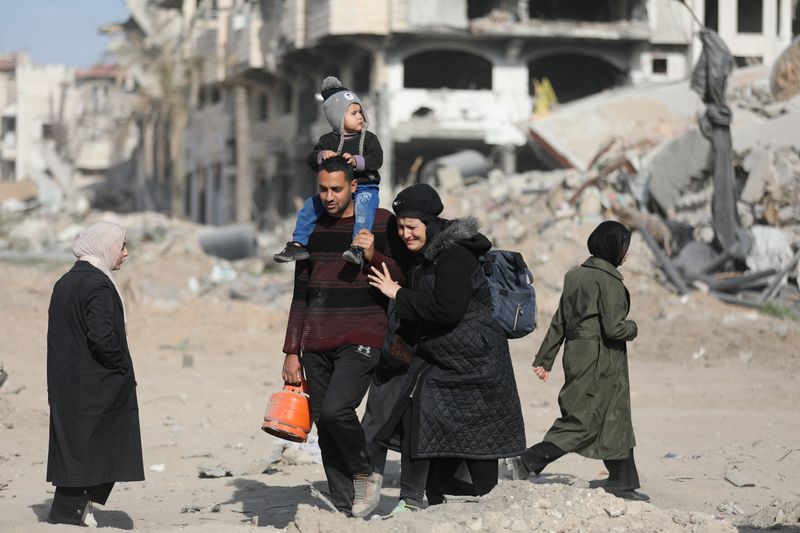Gaza ceasefire deal takes effect and fighting halts after delay By Reuters

Written by Maayan Lobel, Emily Rose, Nidal Al-Mughrabi, and James MacKenzie
JERUSALEM/CAIRO (Reuters) – A ceasefire agreement between Israel and the Islamic Resistance Movement (Hamas) in the Gaza Strip entered into force on Sunday after a delay of about three hours, halting a 15-month war that has brought devastation and seismic political change to the Middle East. .
Residents and a medical worker in Gaza said they had not heard any new fighting or military raids for about half an hour before it was finally implemented.
Palestinian medics said that Israeli air strikes and artillery shelling killed 13 Palestinians between 0630 GMT, when the ceasefire was scheduled to begin, and 0915 GMT, when it actually took effect.
Israel blamed Hamas for the delay after the Palestinian militant group failed to provide a list of the names of the first three hostages to be released under the deal.
Hamas attributed the postponement to “technical” reasons, without specifying what they were.
A Palestinian official familiar with the matter, who spoke on condition of anonymity, said the delay occurred because the mediators requested 48 hours of “calm” before implementing the ceasefire, but that continued Israeli strikes until the deadline made it difficult to send aid. existing.
Two hours after the deadline, Hamas said it had sent the list of names, and Israeli officials confirmed receipt. Hamas said the hostages that were scheduled to be released on Sunday were Rumi Gonen, Doron Steinbrecher and Emily Damari.
Israel did not immediately confirm the names.
The anticipated ceasefire agreement could help end the Gaza war, which began after Hamas, which controls the small coastal area, attacked Israel on October 7, 2023, killing about 1,200 people, according to Israeli authorities.
Israel’s response turned much of the Gaza Strip into rubble and killed nearly 47,000 Palestinians, according to Gaza health authorities.
The war has also set off a confrontation across the Middle East between Israel and its arch-enemy Iran, which supports Hamas and other anti-Israel and anti-US paramilitaries across the region.
Hostage list, last minute attacks
Before the implementation of the ceasefire agreement at 0630 GMT, Israeli Prime Minister Benjamin Netanyahu said that the ceasefire would not enter into force until after Hamas submitted the names of the hostages for release on Sunday.
Israeli military spokesmen said in separate statements on Sunday that their aircraft and artillery attacked “terrorist targets” in northern and central Gaza, and that the army would continue to attack the Strip as long as Hamas did not abide by its obligations under the ceasefire.
The Palestinian Civil Emergency Service said that at least 13 people were killed in the Israeli attacks and dozens were injured. Medics reported that tanks fired on the Zaytoun area of Gaza City, and said that an air strike and tank fire also hit the northern town of Beit Hanoun, prompting residents who had returned there in anticipation of a ceasefire to flee.
The Israeli army said in a separate statement that the siren that sounded in the Sderot area in southern Israel was a false alarm.
Media loyal to Hamas reported early Sunday morning that Israeli forces had begun withdrawing from areas in Gaza’s Rafah to the Philadelphia Corridor along the Egypt-Gaza border.
The three-stage ceasefire agreement came after months of intermittent negotiations brokered by Egypt, Qatar and the United States, and came ahead of the inauguration of US President-elect Donald Trump on January 20.
The first phase will last six weeks, during which 33 of the remaining 98 hostages – women, children, men over 50, the sick and wounded – will be released in exchange for the release of nearly 2,000 Palestinian prisoners and detainees.
They include 737 male and female prisoners and teenagers, some of whom are members of armed groups convicted of attacks that killed dozens of Israelis, as well as hundreds of Palestinians from Gaza who have been detained since the beginning of the war.
The first three are women hostages and are expected to be released through the Red Cross on Sunday. In exchange for the release of 30 Palestinian prisoners in Israeli prisons.
Under the terms of the agreement, Hamas will inform the International Committee of the Red Cross of the meeting location inside Gaza, and the ICRC is expected to begin driving to that location to collect the hostages, an official involved in the operation said. He told Reuters.
End the war?
US President Joe Biden’s team worked closely with Trump’s Middle East envoy Steve Witkoff to push the deal further.
As his inauguration approached, Trump reiterated his demand for the deal to be concluded quickly, repeatedly warning that there would be “hell to pay” if the hostages were not released.
But what will happen next in Gaza remains unclear in the absence of a comprehensive agreement on the future of the Strip after the war, which will require billions of dollars and years of work to rebuild.
Although the ceasefire’s stated goal is to end the war completely, it could easily collapse.
Hamas, which controlled Gaza for nearly two decades, has managed to survive despite losing its senior leadership and thousands of fighters.
Israel has vowed that it will not allow Hamas to return to power and has cleared large swaths of territory inside Gaza, in a move widely seen as a move toward creating a buffer zone that would allow its forces to act freely against threats in the Strip.
In Israel, the return of the hostages may ease some of the public anger against Prime Minister Benjamin Netanyahu and his right-wing government over the October 7 security failure that led to the bloodiest day in the country’s history.
Shock waves in the Middle East
The war sent shockwaves across the region, triggering a conflict with the Tehran-backed Lebanese Hezbollah, and putting Israel in direct conflict with its arch-rival Iran for the first time.
It also changed the Middle East. Iran, which has spent billions building a network of militant groups around Israel, has seen its “axis of resistance” destroyed and has been unable to inflict more than minimal damage on Israel in two major missile attacks.
Hezbollah, whose massive missile arsenal was once seen as Israel’s greatest threat, has seen its senior leadership killed and most of its missiles and military infrastructure destroyed.
On the diplomatic front, Israel has faced anger and isolation over the death and destruction in Gaza.

Netanyahu faces an arrest warrant from the International Criminal Court over allegations of war crimes and separate charges of genocide at the International Court of Justice.
Israel reacted angrily to both cases, dismissing the charges as politically motivated and accusing South Africa, which brought the original case to the International Court of Justice, as well as the countries that joined it, of anti-Semitism.
https://i-invdn-com.investing.com/news/world_news_2_69x52._800x533_L_1419494365.jpg
2025-01-19 10:20:00





